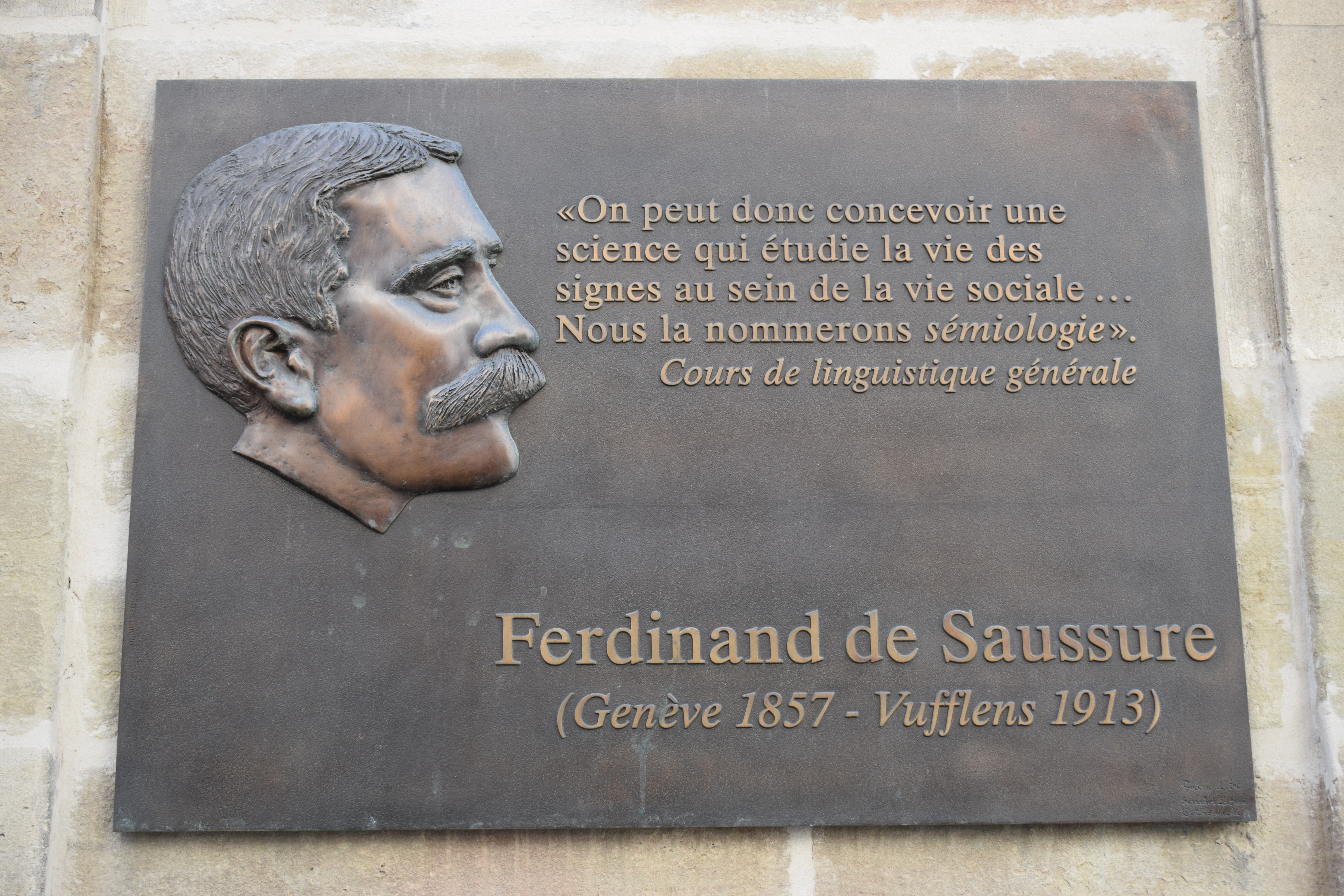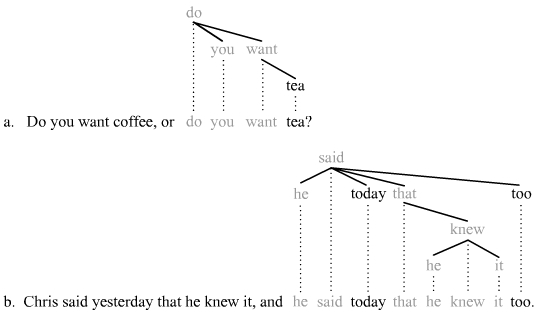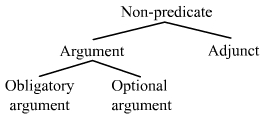|
Coordination (linguistics)
In linguistics, coordination is a complex syntactic structure that links together two or more elements; these elements are called ''conjuncts'' or ''conjoins''. The presence of coordination is often signaled by the appearance of a coordinator ( coordinating conjunction), e.g. ''and'', ''or'', ''but'' (in English). The totality of coordinator(s) and conjuncts forming an instance of coordination is called a coordinate structure. The unique properties of coordinate structures have motivated theoretical syntax to draw a broad distinction between coordination and subordination. It is also one of the many constituency tests in linguistics. Coordination is one of the most studied fields in theoretical syntax, but despite decades of intensive examination, theoretical accounts differ significantly and there is no consensus on the best analysis. Coordinators A ''coordinator'' or a coordinating conjunction, often appears between the conjuncts, usually at least between the penultimate an ... [...More Info...] [...Related Items...] OR: [Wikipedia] [Google] [Baidu] |
Linguistics
Linguistics is the scientific study of language. The areas of linguistic analysis are syntax (rules governing the structure of sentences), semantics (meaning), Morphology (linguistics), morphology (structure of words), phonetics (speech sounds and equivalent gestures in sign languages), phonology (the abstract sound system of a particular language, and analogous systems of sign languages), and pragmatics (how the context of use contributes to meaning). Subdisciplines such as biolinguistics (the study of the biological variables and evolution of language) and psycholinguistics (the study of psychological factors in human language) bridge many of these divisions. Linguistics encompasses Outline of linguistics, many branches and subfields that span both theoretical and practical applications. Theoretical linguistics is concerned with understanding the universal grammar, universal and Philosophy of language#Nature of language, fundamental nature of language and developing a general ... [...More Info...] [...Related Items...] OR: [Wikipedia] [Google] [Baidu] |
X-bar Theory
In linguistics, X-bar theory is a model of phrase structure and a theory of syntactic category formation that proposes a universal schema for how phrases are organized. It suggests that all phrases share a common underlying structure, regardless of their specific category (noun phrase, verb phrase, etc.). This structure, known as the X-bar schema, is based on the idea that every phrase (XP, X phrase) has a Head (linguistics), head, which determines the type (syntactic category) of the phrase (X). The theory was first proposed by Noam Chomsky in 1970Chomsky, Noam (1970). Remarks on Nominalization. In: R. Jacobs and P. Rosenbaum (eds.) ''Reading in English Transformational Grammar'', 184–221. Waltham: Ginn. reformulating the ideas of Zellig Harris (1951), and further developed by Ray Jackendoff (1974, 1977a, 1977bJackendoff, Ray (1977b) Constraints on Phrase Structure Rules, in P. W. Culicover, T. Wasow & A. Akmajian (eds.), ''Formal Syntax'', Academic Press, New York, pp. 249– ... [...More Info...] [...Related Items...] OR: [Wikipedia] [Google] [Baidu] |
Wh-movement
In linguistics, wh-movement (also known as wh-fronting, wh-extraction, or wh-raising) is the formation of syntactic dependencies involving interrogative words. An example in English is the dependency formed between ''what'' and the object position of ''doing'' in "What are you doing?". Interrogative forms are sometimes known within English linguistics as '' wh-words'', such as ''what, when, where, who'', and ''why'', but also include other interrogative words, such as ''how''. This dependency has been used as a diagnostic tool in syntactic studies as it can be observed to interact with other grammatical constraints. In languages with wh- movement, sentences or clauses with a wh-word show a non-canonical word order that places the wh-word (or phrase containing the wh-word) at or near the front of the sentence or clause ("''Whom'' are you thinking about?") instead of the canonical position later in the sentence ("I am thinking about ''you''"). Leaving the wh-word in its canonical pos ... [...More Info...] [...Related Items...] OR: [Wikipedia] [Google] [Baidu] |
Transformational Grammar
In linguistics, transformational grammar (TG) or transformational-generative grammar (TGG) was the earliest model of grammar proposed within the research tradition of generative grammar. Like current generative theories, it treated grammar as a system of formal rules that generate all and only grammatical sentences of a given language. What was distinctive about transformational grammar was that it posited transformation rules that mapped a sentence's deep structure to its pronounced form. For example, in many variants of transformational grammar, the English active voice sentence "Emma saw Daisy" and its passive counterpart "Daisy was seen by Emma" share a common deep structure generated by phrase structure rules, differing only in that the latter's structure is modified by a passivization transformation rule. Basic mechanisms Transformational grammar was a species of generative grammar and shared many of its goals and postulations, including the notion of linguistics as a ... [...More Info...] [...Related Items...] OR: [Wikipedia] [Google] [Baidu] |
Finite Verb
A finite verb is a verb that contextually complements a subject, which can be either explicit (like in the English indicative) or implicit (like in null subject languages or the English imperative). A finite transitive verb or a finite intransitive verb can function as the root of an independent clause. Finite verbs are distinguished from non-finite verbs such as infinitives, participles, gerunds etc. History The term ''finite'' is derived from (past participle of "to put an end to, bound, limit") as the form "to which number and person appertain". Verbs were originally said to be ''finite'' if their form limited the possible person and number of the subject. More recently, finite verbs have been construed as any verb that independently functions as a predicate verb or one that marks a verb phrase in a predicate. Under the first of those constructions, finite verbs often denote grammatical characteristics such as gender, person, number, tense, aspect, mood, modali ... [...More Info...] [...Related Items...] OR: [Wikipedia] [Google] [Baidu] |
Ellipsis (linguistics)
In linguistics, ellipsis () or an elliptical construction is the omission from a clause of one or more words that are nevertheless understood in the context of the remaining elements. There are numerous distinct types of ellipsis acknowledged in theoretical syntax. Theoretical accounts of ellipsis seek to explain its syntactic and semantic factors, the means by which the elided elements are recovered, and the status of the elided elements. Background Varieties of ellipsis have long formed a basis of linguistic theory that addresses basic questions of form–meaning correspondence: in particular, how the usual mechanisms of grasping a meaning from a form may be bypassed or supplanted via elliptical structures. In generative linguistics, the term ''ellipsis'' has been applied to a range of syntax in which a perceived interpretation is fuller than that which would be expected based solely on the presence of linguistic forms. One trait that many types and instances of ellipsis h ... [...More Info...] [...Related Items...] OR: [Wikipedia] [Google] [Baidu] |
Stripping (linguistics)
Stripping or bare argument ellipsis is an ellipsis mechanism that elides everything from a clause except one constituent. It occurs exclusively in the non-initial conjuncts of coordinate structures. One prominent analysis of stripping sees it as a particular manifestation of the gapping mechanism, the difference between stripping and gapping lies merely with the number of remnants left behind by ellipsis: gapping leaves two (and sometimes more) constituents behind, whereas stripping leaves just one. Stripping occurs in many languages and is a frequent occurrence in colloquial conversation. As with many other ellipsis mechanisms, stripping challenges theories of syntax in part because the elided material often fails to qualify as a constituent in a straightforward manner. Examples The following examples illustrate standard cases of stripping. The elided material is indicated using smaller font size and subscripts. ::Susan works at night, and Bill works at night too. ::Why did Sam c ... [...More Info...] [...Related Items...] OR: [Wikipedia] [Google] [Baidu] |
Gapping
In linguistics, gapping is a type of ellipsis that occurs in the non-initial conjuncts of coordinate structures. Gapping usually elides minimally a finite verb and further any non-finite verbs that are present. This material is "gapped" from the non-initial conjuncts of a coordinate structure. Gapping exists in many languages, but by no means in all of them, and gapping has been studied extensively and is therefore one of the more understood ellipsis mechanisms. Stripping is viewed as a particular manifestation of the gapping mechanism where just one remnant (instead of two or more) appears in the gapped/stripped conjunct. Basic examples Canonical examples of gapping have a true "gap", which means the elided material appears medially in the non-initial conjuncts, with a remnant to its left and a remnant to its right. The elided material of gapping in all the examples below is indicated with subscripts and a smaller font: ::Some ate bread, and others ate rice. ::Fred likes to pet ... [...More Info...] [...Related Items...] OR: [Wikipedia] [Google] [Baidu] |
Right Node Raising
In linguistics, the term right node raising (RNR) denotes a sharing mechanism that sees the material to the immediate right of parallel structures being in some sense "shared" by those parallel structures, e.g. '' am likesbut red dislikesthe debates''. The parallel structures of RNR are typically the conjuncts of a coordinate structure, although the phenomenon is not limited to coordination, since it can also appear with parallel structures that do not involve coordination. The term ''right node raising'' itself is due to Postal (1974). Postal assumed that the parallel structures are complete clauses below the surface. The shared constituent was then raised rightward out of each conjunct of the coordinate structure and attached as a single constituent to the structure above the level of the conjuncts, hence "right node raising" was occurring in a literal sense. While the term ''right node raising'' survives, the actual analysis that Postal proposed is not (or no longer) widely ac ... [...More Info...] [...Related Items...] OR: [Wikipedia] [Google] [Baidu] |
Adjunct (grammar)
In linguistics, an adjunct is an optional, or ''structurally dispensable'', part of a sentence, clause, or phrase that, if removed or discarded, will not structurally affect the remainder of the sentence. Example: In the sentence ''John helped Bill in Central Park'', the phrase ''in Central Park'' is an adjunct.See Lyons (1968). A more detailed definition of the adjunct emphasizes its attribute as a modifying form, word, or phrase that depends on another form, word, or phrase, being an element of clause structure with adverbial function. An adjunct is not an argument (linguistics), argument (nor is it a predicative expression), and an argument is not an adjunct. The argument–adjunct distinction is central in most theories of syntax and semantics. The terminology used to denote arguments and adjuncts can vary depending on the theory at hand. Some dependency grammars, for instance, employ the term ''circonstant'' (instead of ''adjunct''), following Lucien Tesnière, Tesnière (195 ... [...More Info...] [...Related Items...] OR: [Wikipedia] [Google] [Baidu] |
Predicative Expression
A predicative expression (or just predicative) is part of a clause predicate, and is an expression that typically follows a copula or linking verb, e.g. ''be'', ''seem'', ''appear'', or that appears as a second complement (object complement) of a certain type of verb, e.g. ''call'', ''make'', ''name'', etc. The most frequently acknowledged types of predicative expressions are predicative adjectives (also predicate adjectives) and predicative nominals (also predicate nominals). The main trait of all predicative expressions is that they serve to express a property that is assigned to a "subject", whereby this subject is usually the clause subject, but at times it can be the clause object. A primary distinction is drawn between predicative (also ''predicate'') and attributive expressions. Further, predicative expressions are typically ''not'' clause arguments, and they are also typically ''not'' clause adjuncts. There is hence a three-way distinction between predicative expressi ... [...More Info...] [...Related Items...] OR: [Wikipedia] [Google] [Baidu] |
Complement (linguistics)
In grammar, a complement is a word, phrase, or clause that is necessary to complete the meaning of a given expression. Complements are often also arguments (expressions that help complete the meaning of a predicate). Predicative, subject and object complements In many non-theoretical grammars, the terms '' subject complement'' (also called a predicative of the subject) and '' object complement'' are employed to denote the predicative expressions (predicative complements), such as predicative adjectives and nominals (also called a predicative nominative or predicate nominative), that serve to assign a property to a subject or an object: ::Ryan is upset. – Predicative adjective as subject complement ::Rachelle is the boss. – Predicative nominal as subject complement ::That made Michael lazy. – Predicative adjective as object complement ::We call Rachelle the boss. – Predicative nominal as object complement This terminology is used in grammar books: However, this use o ... [...More Info...] [...Related Items...] OR: [Wikipedia] [Google] [Baidu] |






